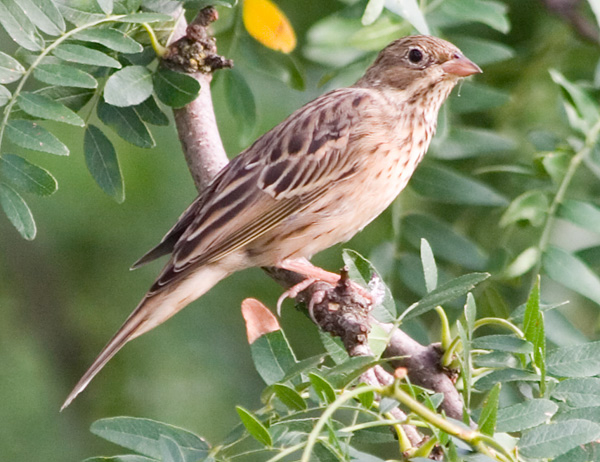
Photo © phenolog
The ortolan (Emberiza hortulana), also called ortolan bunting, is a Eurasian bird in the bunting family Emberizidae, a passerine family now separated by most modern scholars from the finches, Fringillidae. The genus name Emberiza is from Alemannic German Embritz, a bunting. The specific name hortulana is from the Italian name for this bird, ortolana. The English ortolan is derived from Middle French hortolan, "gardener".
The ortolan is served in French cuisine, typically cooked and eaten whole. Traditionally diners cover their heads with their napkin or a towel while eating the delicacy. The bird is so widely used that its French populations dropped dangerously low, leading to laws restricting its use in 1999. In September 2007, the French government announced its intent to enforce long-ignored laws protecting the bird.
The ortolan bunting was described by the Swedish naturalist Carl Linnaeus in 1758 in the tenth edition of his Systema Naturae and retains its original binomial name of Emberiza hortulana. The species is monotypic. A molecular phylogenetic study of the buntings published in 2008 found that the ortolan bunting is most closely related to Cretzschmar's bunting (Emberiza caesia).
The ortolan bunting is 16–17 cm (6.3–6.7 in) in length and has a wing-span of 23–29 cm (9.1–11.4 in). In appearance and habits it much resembles its relative the yellowhammer, but lacks the bright colouring of that species; the ortolan's head, for instance, is greenish-grey, instead of a bright yellow. The song of the male ortolan resembles that of the yellowhammer.
A native of most European countries and western Asia, it reaches as far north as Scandinavia and beyond the Arctic Circle, frequenting cornfields and their neighbourhoods. It is an uncommon vagrant in spring, and particularly autumn, to the British Isles. Sightings in the UK are less common than they were, owing to the species’ population decline due to overexploitation in France.
It was spotted at Kenjar Coastal Karnataka, India, in November 2018 and photographed by birdwatchers. Some birders commented that it is the first photographic record of an ortolan bunting in India.
Ortolan nests are placed on or near the ground.
The maximum age recorded is six years and ten months for a bird found dead in Switzerland.
Seeds are the natural diet, but beetles and other insects are taken when feeding their young.
The birds are caught with nets set during their autumn migratory flight to Africa. They are then kept in covered cages or boxes. The birds react to the dark by gorging themselves on grain, usually millet seed, until they double their bulk. The birds are then thrown into a container of Armagnac, which both drowns and marinates the birds.
The bird is roasted for eight minutes and then plucked. The consumer then places the bird feet first into their mouth while holding onto the bird's head. The ortolan is then eaten whole, with or without the head, and the consumer spits out the larger bones. The traditional way French gourmands eat ortolans is to cover their heads and face with a large napkin or towel while consuming the bird. The purpose of the towel is debated. Some claim it is to retain the maximum aroma with the flavour as they consume the entire bird at once, others have stated "Tradition dictates that this is to shield – from God’s eyes – the shame of such a decadent and disgraceful act", and others have suggested the towel simply hides the consumers spitting out bones. This use of the towel was begun by a priest, a friend of Jean Anthelme Brillat-Savarin.
At one time, the island of Cyprus formed a chief depot for the export of ortolans, which were pickled in spices and vinegar and packed in casks containing from 300 to 400 each. In the early 20th century, between 400 and 500 casks were annually exported from Cyprus.
Ortolan hunting was banned in France in 1999, but the law was poorly enforced and it is thought that up to 50,000 ortolans were illegally killed each year during the autumn migration: mostly birds from breeding grounds in Finland and the Baltic area. According to France's League for the Protection of Birds, France's ortolan population fell 30% between 1997 and 2007. In 2007, the French government vowed to strictly enforce some existing rules about banning the practice, with the maximum fine set at €6,000 (£4,800 or $6,728). Killing and cooking ortolans is banned across the EU. In 2007, the pressure from France's League for Protection of Birds and from the European Union resulted in the French government promising to enforce the EU directive protecting the ortolan. After several years of active citizen watch revealing little if any change in the field situation, the local representative of the government repeated this statement in 2016.
European Union member states prohibit:
As of 2018, the overall Ortolan bunting's population is listed by the IUCN as Least Concern (LC). However, a 2019 study using stable isotopes, archival light geologgers, and population genetics suggests the species is in decline.
Source: Wikipedia